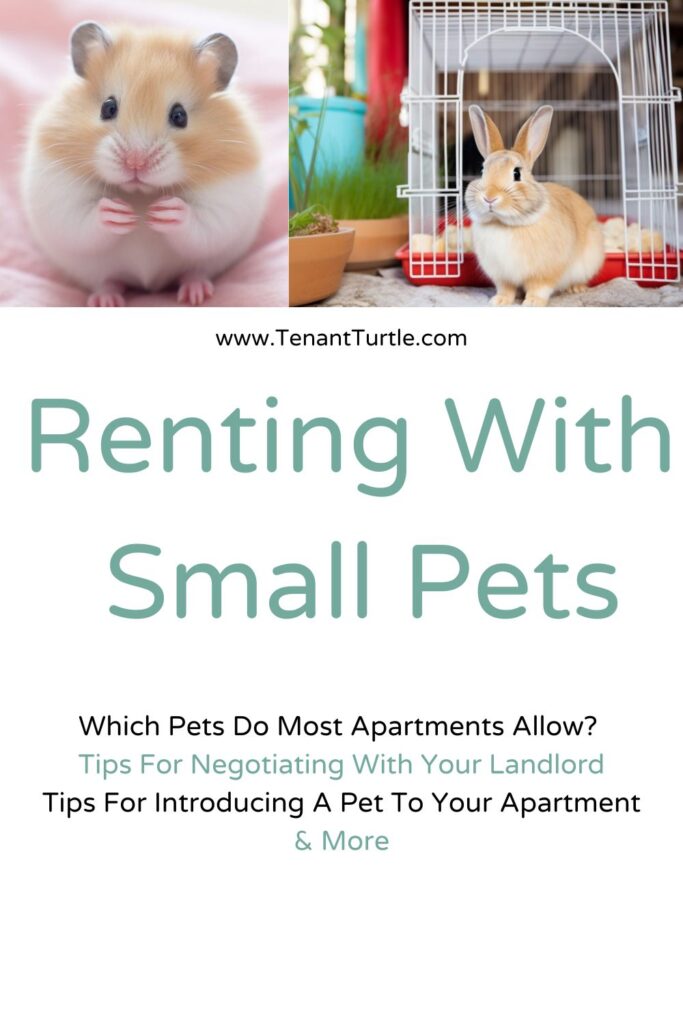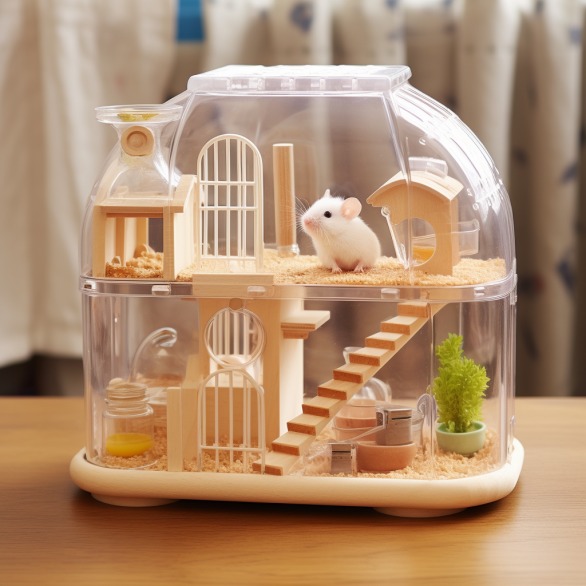
Renting with Small Pets: Your Guide to Finding Pet-Friendly Apartments
Finding a new place to call home can be both exciting and challenging, especially when you have small pets. As a devoted pet parent, you want to ensure that your furry, scaly, or feathery friends can live comfortably with you. In this guide, we’ll address common questions and concerns related to renting with small pets, ensuring a smooth transition to your new pet-friendly apartment.

Is it hard to find a place to rent when you have small pets?
While it can be challenging to find pet-friendly apartments, it’s not impossible. Many landlords and property managers now recognize the value of pet-loving tenants. To improve your chances, be honest about your pet during your apartment search, consider smaller, more manageable pets, and offer a pet resume with references from previous landlords.
Do ‘no pets’ apartments include hamsters?
In most cases, apartments that specify “no pets” typically refer to traditional domesticated animals like cats and dogs. Hamsters, being small and contained, may not fall under this restriction. However, it’s always best to check with the landlord or property manager to avoid any misunderstandings.
If an apartment says no pets can I have fish?
Yes, most landlords and property managers are generally okay with fish tanks or aquariums. Fish are considered low-maintenance and don’t pose the same concerns as other pets. Just ensure you take proper care of the aquarium and avoid any potential water damage.

If a landlord says no pets allowed, can I have a guinea pig?
In many cases, guinea pigs are considered part of the small pets category, and some landlords might make exceptions for them. However, always communicate openly with the landlord and seek written permission to have a guinea pig to avoid any future issues.
Can I have a bunny or rabbit in an apartment that doesn’t allow cats or dogs?
Bunnies or rabbits can be great apartment companions, especially if the apartment doesn’t allow cats or dogs. They are typically quiet and can be litter-trained. However, remember to get explicit approval from your landlord before bringing a bunny home.
Can I have a pet axolotl in an apartment that says no pets?
Since axolotls are aquatic pets and generally don’t cause damage or noise issues, some landlords might consider them as an exception. However, it’s essential to get written consent from your landlord before getting an axolotl.
Can my child have a pet frog in our apartment that says no pets?
As with the axolotl, pet frogs are generally low-maintenance and unlikely to damage property. While some landlords might allow them, it’s always best to seek permission beforehand to avoid any potential problems.
Can we get a pet hedgehog if our landlord doesn’t allow pets?
Hedgehogs are unconventional pets and may not be explicitly addressed in the rental agreement. It’s crucial to discuss this unique pet option with your landlord to determine whether they are comfortable with it. Some US states have laws against hedgehogs as pets, so it certainly isn’t allowed in those states.
I used to have a pet hedgehog and I had two different landlords while I owned the hedgehog. Both were pet-friendly but required an extra pet deposit and monthly pet fee for cats or dogs. In the case of our hedgehog, neither landlord required a pet deposit or monthly pet rent.
Do most apartments allow pet reptiles?
Reptiles are generally low-impact pets, and some landlords may allow them even if they have a “no pets” policy. However, always check with your landlord and obtain written approval before bringing a reptile home.
Can I have a pet snake if an apartment says no pets allowed?
Snakes are often a point of contention due to people’s varying comfort levels. If your landlord has a strict “no pets” policy, it might be challenging to have a pet snake. However, you can always try discussing the matter with them or explore other pet-friendly apartments.
Can I have a pet chinchilla in a rental that says no pets?
Having a pet chinchilla in a rental that explicitly states “no pets” can be challenging, but it’s not entirely impossible. Chinchillas are quiet, clean, and low-odor pets, which might work in your favor when discussing the matter with your landlord.

What are good pets for apartment living?
Small, low-maintenance pets are ideal for apartment living. Some popular choices include:
-
- Cats (if the apartment allows them).
-
- Small dog breeds suitable for apartment living.
-
- Fish (aquariums or fish tanks).
-
- Hamsters, gerbils, or mice.
-
- Guinea pigs.
-
- Birds (like budgies or cockatiels).
-
- Reptiles (if permitted).
Are there any additional pet deposits or fees for having small pets?
Many apartments may require a pet deposit or a monthly pet fee. This fee is meant to cover any potential damages or extra cleaning related to your pets. The amount may vary, so it’s best to inquire about this during your apartment search.
What are the potential issues or challenges of having small pets in a rental apartment?
-
- Damage: Some pets, especially those prone to chewing or scratching, may inadvertently cause damage to the apartment.
-
- Noise: If your pet is noisy or vocal, it could disturb neighbors, leading to complaints.
-
- Allergies: Some tenants might be allergic to certain pets, and this could create tensions in shared living spaces.
-
- Pet Restrictions: Specific breeds or types of pets may be restricted by the apartment complex or local regulations.
How to introduce a new small pet to an apartment environment?
-
- Create a Safe Space: Prepare a designated area with your pet’s bed, food, and water bowls.
-
- Gradual Introduction: Allow your pet to explore the apartment slowly, one room at a time.
-
- Supervision: Always supervise your pet during the introduction phase to prevent accidents.
-
- Patience: Give your pet time to adjust to the new environment; it might be overwhelming at first.
-
- Positive Reinforcement: Reward good behavior with treats or praise to reinforce positive associations.
What are some tips for keeping the apartment clean and odor-free with small pets?
-
- Regular Cleaning: Clean up after your pet daily, such as litter boxes, cages, or designated potty areas.
-
- Proper Ventilation: Ensure good airflow in your apartment to reduce odors.
-
- Pet-Friendly Cleaners: Use pet-safe cleaning products to avoid any harm to your furry friend.
-
- Grooming: Regularly groom your pets to minimize shedding and dander.
-
- Launder Pet Bedding: Wash your pet’s bedding and toys regularly.
How to Negotiate with Your Landlord over a Small Pet
1. Initiate the Conversation
Arrange a meeting with your landlord to discuss the possibility of having a small pet in the apartment. Choose a time when they are not rushed and can give the matter proper attention.
2. Highlight the Benefits
Start the conversation by emphasizing the positive aspects of having a small pet, such as chinchilla or any other rare pet. Mention the benefits, like stress reduction, companionship, and your commitment to responsible pet ownership.
3. Offer a Pet Deposit
One way to reassure your landlord is to propose a pet deposit. This deposit can cover any potential damages caused by your pet during the tenancy. Assure the landlord that you are willing to cover any costs beyond the deposit for damages, if necessary.
4. Suggest a Monthly Pet Fee
To further ease your landlord’s concerns, offer to pay a monthly pet fee. This fee can help cover the cost of additional cleaning or wear-and-tear caused by your small pet. It shows your willingness to take responsibility for any potential issues.
5. Provide a Pet Resume
Offer a well-prepared pet resume for your small pet. Include details about their age, breed, temperament, training, and any previous rental experiences. Highlight any certifications or training your pet has undergone to demonstrate its good behavior.
6. Prepare an Information Packet
If your small pet is a rare or exotic species, consider providing an information packet. Include details about their behavior, housing requirements, and care needs. Explain why your chosen pet won’t be disruptive or damaging to the apartment.
7. Address Concerns Proactively
During the negotiation, be proactive in addressing any potential concerns your landlord may have. Discuss how you’ll prevent noise issues, property damage, or odor problems. Reiterate that you’ll be responsible for any necessary repairs or cleaning.
8. Show Your Responsibility as a Tenant
Highlight your track record as a responsible and respectful tenant. Share any positive references from previous landlords, demonstrating that you’ve been a reliable renter.
9. Sign a Pet Agreement
If your landlord agrees to allow the small pet, ensure that both parties sign a pet agreement. This agreement should clearly outline the terms of pet ownership, including any pet-related rules and expectations.
10. Follow Through on Promises
Once you’ve successfully negotiated and gained approval, be sure to fulfill your promises. Pay the pet deposit and monthly fee on time, and always adhere to the terms of the pet agreement. This will reinforce your credibility as a responsible pet owner.

Leave a Comment